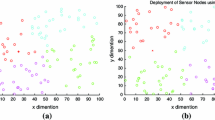Abstract
Wireless Sensor Network is equipped with several nodes and is mainly developed for monitoring environmental-oriented applications. Generally, sensor nodes are inbuilt with autonomy battery power so that nodes can perform adequate operations by communicating among themselves. Minimization of energy expenditure among nodes and choosing the optimal path for data transmission is still a challenging task. The motive is to reduce the energy expenditure among each node and to reduce the network traffic among the nodes present nearer to the Base Station simultaneously. Distributed, Uneven Clustering approach with Energy Efficient protocol is proposed for balancing network traffic and to produces energy-efficient routes among wireless nodes. This proposed mechanism contributes two phases, namely Distributed Clustering phase and the Data Routing phase. The sensor node has the highest cooperativeness rate, data transmission rate, and residual energy is selected as a CH and backup CH for balancing the network load and overall energy consumption of the network. In this approach, select the intermediate CH using Fuzzy Interference System is predicting the sensor link quality by energy density factor, Communication rate, Packet delivery rate, and size of queue parameters. The performance metrics are evaluated, improving energy efficiency and throughput is given for the proposed mechanism.










Similar content being viewed by others
References
Jawad, H. M., Nordin, R., Gharghan, S. K., Jawad, A. M., & Ismail, M. (2017). Energy-efficient wireless sensor networks for precision agriculture: A review. Sensors, 17(8), 1781.
Tan, H. Ö., & Körpeoǧlu, I. (2003). Power-efficient data gathering and aggregation in wireless sensor networks. ACM Sigmod Record, 32(4), 66–71.
Yu, J., Qi, Y., Wang, G., & Gu, X. (2012). A cluster-based routing protocol for wireless sensor networks with non-uniform node distribution. AEU-International Journal of Electronics and Communications, 66(1), 54–61.
Brar, G. S., Rani, S., Chopra, V., Malhotra, R., Song, H., & Ahmed, S. H. (2016). Energy-efficient direction-based PDORP routing protocol for WSN. IEEE Access, 4, 3182–3194.
Khapre, S. P., Chopra, S., Khan, A., Sharma, P., & Shankar, A. (2020). Optimized routing method for wireless sensor networks based on improved ant colony algorithm. In 2020 10th international conference on cloud computing, data science & engineering (Confluence) (pp. 455–458). IEEE.
Buratti, C., Giorgetti, A., & Verdone, R. (2005). Cross-layer designs of an energy-efficient cluster formation algorithm with carrier-sensing multiple accesses for wireless sensor networks. EURASIP Journal on Wireless Communications and Networking, 2005(5), 672–685.
Yu, Z., Wei, J., & Liu, H. (2009). An energy-efficient target tracking framework in wireless sensor networks. EURASIP Journal on Advances in Signal Processing, 2009, 26.
Younis, O., & Fahmy, S. (2004). HEED: A hybrid, energy-efficient, distributed clustering approach for ad hoc sensor networks. IEEE Transactions on Mobile Computing, 3(4), 366–379.
Hoang, D. C., Yadav, P., Kumar, R., & Panda, S. K. (2014). Real-time implementation of a harmony search algorithm-based clustering protocol for energy-efficient wireless sensor networks. IEEE Transactions on Industrial Informatics, 10(1), 774–783.
Kumar, P., & Chaturvedi, A. (2016). Spatio-temporal probabilistic query generation model and sink attributes for energy-efficient wireless sensor networks. IET Networks, 5(6), 170–177.
Chang, J. Y., & Ju, P. H. (2012). An efficient cluster-based power saving scheme for wireless sensor networks. EURASIP Journal on Wireless Communications and Networking, 2012(1), 172.
Aslam, M., Munir, E. U., Rafique, M. M., & Hu, X. (2016). Adaptive energy-efficient clustering path planning routing protocols for heterogeneous wireless sensor networks. Sustainable Computing Informatics and Systems, 12, 57–71.
Liu, H. H., Su, J. J., & Chou, C. F. (2015). On energy-efficient straight-line routing protocol for wireless sensor networks. IEEE Systems Journal, 11, 2374–2382.
Tabus, V., Moltchanov, D., Koucheryavy, Y., Tabus, I., & Astola, J. (2015). Energy-efficient wireless sensor networks using linear programming optimization of the communication schedule. Journal of Communications and Networks, 17(2), 184–197.
Yang, D., Shin, J., Kim, J., & Kim, G. H. (2015). OPEED: Optimal energy-efficient neighbour discovery scheme in opportunistic networks. Journal of Communications and Networks, 17(1), 34–39.
Mann, P. S., & Singh, S. (2017). Improved metaheuristic based energy-efficient clustering protocol for wireless sensor networks. Engineering Applications of Artificial Intelligence, 57, 142–152.
Cenedese, A., Luvisotto, M., & Michieletto, G. (2017). Distributed clustering strategies in industrial wireless sensor networks. IEEE Transactions on Industrial Informatics, 13(1), 228–237.
Wang, Y., Li, X. Y., Song, W. Z., Huang, M., & Dahlberg, T. A. (2011). Energy-efficient localized routing in random multihop wireless networks. IEEE Transactions Parallel and Distributed Systems, 22(8), 1249–1257.
Wu, S., Chou, W., Niu, J., & Guizani, M. (2018). Delay-aware energy-efficient routing towards a path-fixed mobile sink in industrial wireless sensor networks. Sensors, 18(3), 899.
Zhang, W., Li, L., Han, G., & Zhang, L. (2017). E2HRC: An energy-efficient heterogeneous ring clustering routing protocol for wireless sensor networks. IEEE Access, 5, 1702–1713.
Singh, S., Malik, A., & Kumar, R. (2017). Energy-efficient heterogeneous DEEC protocol for enhancing lifetime in WSNs. Engineering Science and Technology an International Journal, 20(1), 345–353.
Shen, J., Wang, A., Wang, C., Hung, P. C., & Lai, C. F. (2017). An efficient centroid-based routing protocol for energy management in WSN-assisted IoT. Ieee Access, 5, 18469–18479.
Cao, Y., & Pan, H. (2020). Energy-efficient cooperative spectrum sensing strategy for cognitive wireless sensor networks based on particle swarm optimization. IEEE Access, 8, 214707–214715.
Rasheedl, M. B., Javaid, N., Javaid, A., Khan, M. A., Bouk, S. H., & Khan, Z. A. (2013). Improving network efficiency by removing energy holes in WSNs. Journal of Basic and Applied Scientific Research, 1-11.
Khan, T. F., & Kumar, D. S. (2020). Ambient crop field monitoring for improving context-based agricultural by mobile sink in WSN. Journal of Ambient Intelligence and Humanized Computing, 11(4), 1431–1439.
Author information
Authors and Affiliations
Corresponding author
Additional information
Publisher's Note
Springer Nature remains neutral with regard to jurisdictional claims in published maps and institutional affiliations.
Rights and permissions
About this article
Cite this article
Manoharan, L., Leni, A.E.S. Distributed Uneven Clustering Mechanism for Energy Efficient WSN. Wireless Pers Commun 121, 153–169 (2021). https://doi.org/10.1007/s11277-021-08628-4
Accepted:
Published:
Issue Date:
DOI: https://doi.org/10.1007/s11277-021-08628-4




